I know that just about the last thing on anyone’s mind in December is gardening, no matter where you live. But just in case you need to get outdoors to clear your head of all those lists and too much eggnog, here are a few garden chores that can be done now, without taking too much time from your festivities. And if you’re lucky enough to have plenty of evergreens and berries in your yard, now if a good time to prune and to have them do double duty as decorations.
This year, consider purchasing a living Christmas tree for your home. They really aren’t that much more expensive than a cut tree. This is an excellent way to improve your landscape, and at the same time, save a tree. Before bringing a living tree into the house, water it thoroughly. Living Christmas trees should not be kept in the house for any longer than 10 days.
Keep your Christmas Tree Fresh
If you choose a pre-cut tree, cut 1-2 inches off the stump and place it into a bucket of warm, clean water as soon as you get it home. In the first 24 hours after cutting, it will absorb as much as a gallon of water.
A fresh tree will absorb about 1 quart of water per inch of trunk diameter every 24 hours. Check your tree stand daily; add water as needed. Do not let a live Christmas tree dry out: If the cut dries out, it heals over and stops absorbing water. If your tree does run out of water, it’s possible to remedy the situation by making a fresh cut.
Perennials, annuals, and bulbs
If you potted up some bulbs, such as hyacinths, daffodils or tulips, last September for winter forcing, keep an eye on them. Make sure they remain moist, and in the dark until they have established their root systems. It is possible that they have already filled their containers with roots and that the new top growth has begun. If this is so, bring them into the house and set them in a cool room, in indirect light. After a week or so, move them into bright light, and watch them go to town!
Check on any corms and tubers which you dug up, and stored this fall. Remove and discard any which show signs of disease or rot.
Shrubs and trees
Winter rains tend to make you forget about watering your garden. However, plants and shrubs which are growing beneath large evergreens or under the eaves of the house, may be bone dry by this time. Lack of water in the cold winter months can be fatal to many of these plants. A quick check will let you know if you need to do a little winter watering.
If there is a sudden drop in the temperature, provide extra protection for your more tender flowering plants like Rhododendrons, Camellias, Azaleas and Daphne. You can provide temporary, emergency protection by driving in three of four stakes around the plant, and then simply covering the plant with some type of cloth, like burlap, a sheet or an old blanket. Don’t let this material come into direct contact with the leaves of the plant. Remove the cover completely, as soon as the weather moderates.
December is a good month to take cuttings of rhododendrons, azaleas, and other evergreen shrubs. The cutting should be taken from new tip growth, and kept in bright light, at about 70°.
Lawn
Stay off frozen grass!!! Normally, when you walk across a lawn, the individual blades of grass are elastic. They bend underfoot and soon bounce back without damage. When the grass is covered with frost, it loses its elasticity and blades will break, not bend. To add insult to injury, these spots will not go away soon. It being winter, the grass won’t begin to grow again until spring and that’s how long those spots could remain in the lawn.
In the interest of science, the next frosty morning, innocently wander onto your lawn (I wouldn’t suggest walking on a neighbor’s lawn, even one you don’t like to perform this test) and do a little river dance. Within a day or so you’ll be able to count the steps by the annoying brown footprints you have left behind.
Dealing with Snow and Ice
When you’re shoveling or blowing snow, get more for your effort by spreading it onto your planting beds as free mulch. One exception: Don’t use snow pushed up from the street; it may contain plant-damaging salts.
If your area experiences a heavy, wet snowfall and you’re concerned about the weight breaking the branches of prized trees and shrubs, you can attempt removal. Use a broom and with gentle upward motions, sweep the snow off. Don’t knock on branches to shake snow loose; frozen branches may be brittle and are more likely to break from being shaken than from the weight of the snow.
Pay attention to ice-melt products you use to avoid damage to trees, shrubs, perennials, and your lawn. Most products contain salt (sodium chloride). Plants are damaged the most by ice melts that contain sodium or calcium chloride. Potassium chloride is less harmful to plants. In general, ice melt that is labeled pet-friendly is safe for plants.
Or, use materials such as sand or non-clumping kitty litter to create traction in icy areas.
Set out a nice big basket to hold all those garden catalogs that have started arriving already so you can read them after the holidays, at your leisure.
